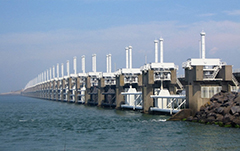Holland’s Barriers to The Sea
The Delta Works is a series of construction projects in the southwest of the Netherlands to protect a large area of land around the Rhine-Meuse-Scheldt delta from the sea. The works consist of dams, sluices, locks, dykes, levees, and storm surge barriers located in the provinces of South Holland and Zeeland.
The aim of the dams, sluices, and storm surge barriers was to shorten the Dutch coastline, thus reducing the number of dikes that had to be raised. Along with the Zuiderzee Works, the Delta Works have been declared one of the Seven Wonders of the Modern World by the American Society of Civil Engineers.
The aim of the dams, sluices, and storm surge barriers was to shorten the Dutch coastline, thus reducing the number of dikes that had to be raised. Along with the Zuiderzee Works, the Delta Works have been declared one of the Seven Wonders of the Modern World by the American Society of Civil Engineers.
 The original plan of Delta Works was completed by the Europoortkering which required the construction of the Maeslantkering in the Nieuwe Waterweg between Maassluis and Hoek van Holland and the Hartelkering in the Hartel Canal near Spijkenisse. The works were declared finished after almost forty years in 1997. In reality the works were finished on 24 August 2010 with the official opening of the last strengthened and raised retaining wall near the city of Harlingen, Netherlands.
The original plan of Delta Works was completed by the Europoortkering which required the construction of the Maeslantkering in the Nieuwe Waterweg between Maassluis and Hoek van Holland and the Hartelkering in the Hartel Canal near Spijkenisse. The works were declared finished after almost forty years in 1997. In reality the works were finished on 24 August 2010 with the official opening of the last strengthened and raised retaining wall near the city of Harlingen, Netherlands.Due to climate change and relative sea-level rise, the dikes will eventually have to be made higher and wider. This is a long term uphill battle against the sea. The needed level of flood protection and the resulting costs are a recurring subject of debate, and involve a complicated decision-making process. In 1995 it was agreed in the Delta Plan Large Rivers and Room for the River projects that about 500 kilometres of insufficient dyke revetments were reinforced and replaced along the Oosterschelde and Westerschelde between 1995 and 2015. After 2015, under the High Water Protection Program, additional upgrades are made.
In September 2008, the Delta Commission presided by politician Cees Veerman advised in a report that the Netherlands would need a massive new building program to strengthen the country's water defenses against the anticipated effects of global warming for the next 190 years. The plans included drawing up worst-case scenarios for evacuations and included more than €100 billion, or $144 billion, in new spending through the year 2100 for measures, such as broadening coastal dunes and strengthening sea and river dikes. The commission said the country must plan for a rise in the North Sea of 1.3 meters by 2100 and 4 meters by 2200. More details
